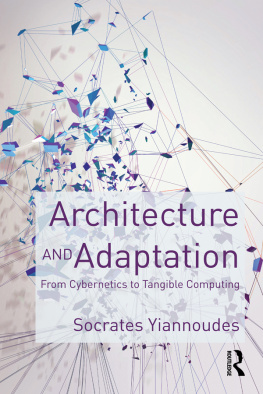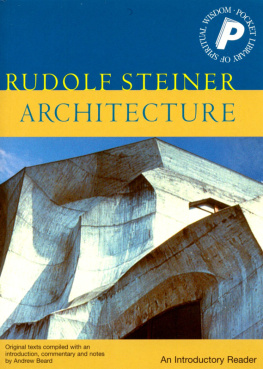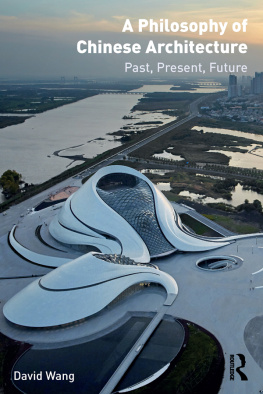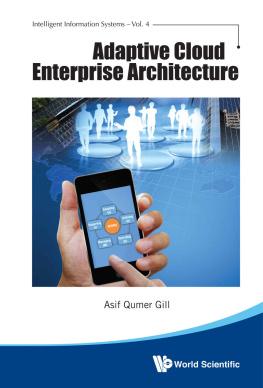First published 2016
by Routledge
711 Third Avenue, New York, NY 10017
and by Routledge
2 Park Square, Milton Park, Abingdon, Oxon OX14 4RN
Routledge is an imprint of the Taylor & Francis Group, an informa business
2016 Taylor & Francis
The right of Socrates Yiannoudes to be identified as author of this work has been asserted by him in accordance with sections 77 and 78 of the Copyright, Designs and Patents Act 1988.
All rights reserved. No part of this book may be reprinted or reproduced or utilised in any form or by any electronic, mechanical, or other means, now known or hereafter invented, including photocopying and recording, or in any information storage or retrieval system, without permission in writing from the publishers.
Trademark notice: Product or corporate names may be trademarks or registered trademarks, and are used only for identification and explanation without intent to infringe.
Library of Congress Cataloguing in Publication Data
Yiannoudes, Socrates, author.
Architecture and adaptation : from cybernetics to tangible
computing / Socrates Yiannoudes.
pages cm
Includes bibliographical references and index.
1. Architecture Human factors. 2. Architecture and technology.
3. Smart materials in architecture. 4. Architecture Technological
innovations. I. Title.
NA2542.4.Y39 2016
720.47dc232015027889
ISBN: 978-1-138-84315-8 (hbk)
ISBN: 978-1-138-84316-5 (pbk)
ISBN: 978-1-315-73111-7 (ebk)
Acquisition Editor: Wendy Fuller
Editorial Assistant: Grace Harrison
Production Editor: Ed Gibbons
Typeset in Bembo
by HWA Text and Data Management, London

Its a long walk from antique automata to drone-assembled foam blocks and inhabited muscles, but this is the promenade architecturale on which Socrates Yiannoudes invites us. At issue is a broad ontological question: where is the dividing line between the animate and the inanimate, and where should we situate architecture with respect to this line? With one foot in science fiction and the other solidly planted in real-time reality, Yiannoudes takes seriously what have often been seen as fringe concerns avant-garde or just in left field in architectural thought.
What makes this book special and perhaps unique is that Yiannoudes is not just an observer, but an actual participant in the movement he describes. At once scholarly and engaged, the book tries to help us understand both the longue dure tendencies and the current potential of approaches that explore the relationship between the living world and architecture.
A central image is that of the conversation, or the notion of open-ended reciprocal exchange. Conversation, as the cyberneticist Gordon Pask affirms, is a process of conjoint concept execution, by participants A and B, as a result of which the agreed part of the concept is distributed or shared and cannot be functionally assigned to A or to B. This image highlights the central question of our relationship to machines, and by extension to so-called intelligent environments: is there, or can there be, any sort of common ground between our artificial constructs and ourselves, as agents, actants, participants in a conversation?
It is perhaps not accidental that one of the first conversations to be re-conceptualized in terms of artificial intelligence was psychoanalytic. A primitive computer program called ELIZA, written by Joseph Weizenbaum at MIT between 1964 and 1966, during the heyday of AI optimism about the potential of natural-language processing, simulated the conversational responses of a psychoanalyst to affirmations or questions typed in by a human patient. The results were extraordinarily fertile, given the very basic methods and parameters undergirding the program. Many users (including myself) have been intrigued and disturbed by the responses generated by ELIZA. ELIZA is able to simulate convincingly a therapists approach, because the therapistpatient relationship (in this model of non-directive therapy) requires very little common ground, and the conversational model puts almost all of the burden of information on the patient. ELIZAs responses are therefore not required, in order to appear human, to draw on a shared context of experience.
Extrapolating from this example, one of the key insights of this book is to underline the importance of asymmetry in the relationship between human and machinic actors: is conversation necessarily symmetrical? Yiannoudes affirms that it is not, and that in fact the most productive interactive relations, in general, are more likely to be asymmetrical. This does not mean that AI and A-Life should not be ambitious in the production of adaptive environments; but their ambitions should not be formally attached to symmetry in terms of shared contextual information. The future of our efforts to make environments intelligent and adaptive does not, in fact, depend on our ability to force upon them our own characteristics.
Perhaps the other crucial notion in this book, which subtly threads through the text, is that of affordance. The interaction between humans and architecture is no doubt best conceptualized in terms of this complex concept. Affordance is a quality of an object or environment that permits or invites certain manipulations for instance, the handle of a teacup is an invitation to hold it, pick it up, and drink from it. Some teacups do not have handles, notably in the Japanese tradition, in which case the affordance of the teacup is less directive, more intuitive. In the same vein, the affordances of the environment can be quite broad and indirect: how to characterize, for example, the affordances of a public square? Its benches, ground surface, borders and trees are so many ambiguous affordances, allowing for but not determining any particular behavior. This is just as true of the machinically- or electronically-enhanced domestic environment, at least in the viewpoint of this book. Interaction with an intelligent environment, as Yiannoudes sees things, is open-ended, meaning indeterminate and subject to the effects of learning on the part of both user and environment. Yiannoudes is resolutely in favor of pragmatic advances rather than flashy, one-off coups: following Malcom McCullough, he prefers the affordances of everyday life rather than fashionable statements in form.
The reader will find this book to be a reliable guide to the last five decades of reflection on interactions between architecture and cybernetics, between living users and semi-autonomous environments, between fantasy and reality, in the matter of AI and A-Life. At ease with both the technical and philosophical sides of the question, Yiannoudes is uniquely suited for this work. He is capable of explaining the most arcane configuration of sensors and actuators, while in a subsequent paragraph summarizing the phenomenological tradition in philosophy.
Despite its welcome and thorough interrogation of architectural flights of fancy from Cedric Price to Kas Oosterhuis, this book comes back, again and again, to the potential of interactive environments for real-world advances in the service of users. It sees ambient intelligence as an extra layer and a needed one for architecture, just as, more than a century ago, HVAC and other mechanical systems began to be adjoined to domestic and public space.
Architecture and Adaptation is an appropriate title for a work that is itself supple and adaptive, with serene descriptions of the most far-fetched conceptual projects, combined with level-headed assertions about what is most needed in terms of architectural values. Yiannoudes looks forward to a new generation of architectural work not so far from where we are now when so-called new technologies will be simply incorporated in our everyday architectural life; when it will not be a question of if, but of how, the conversation between us and architecture, our inanimate twin, will be consummated.









